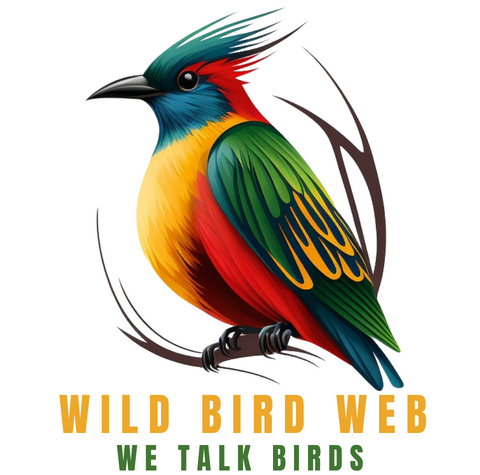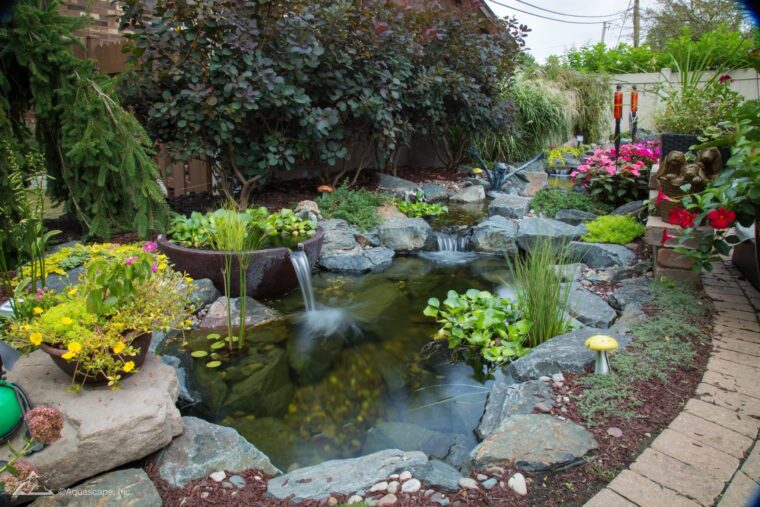Ponds act like busy roadside diners for migrating birds, offering quick calories, safe cover, and a drink during long flights.
Plants do the heavy lifting here, feeding insects that birds eat, cleaning water through nutrient uptake, and calming waves so shorelines do not erode.
Native species shine in this role, fitting local soils and seasons, matching native insects, and sustaining a stable food web without extra fuss.
Thoughtful planting turns a simple water feature into a seasonal lifesaver for ducks, shorebirds, warblers, thrushes, and more.
Without further ado, let us begin.
Core Principles for Planting Around Ponds
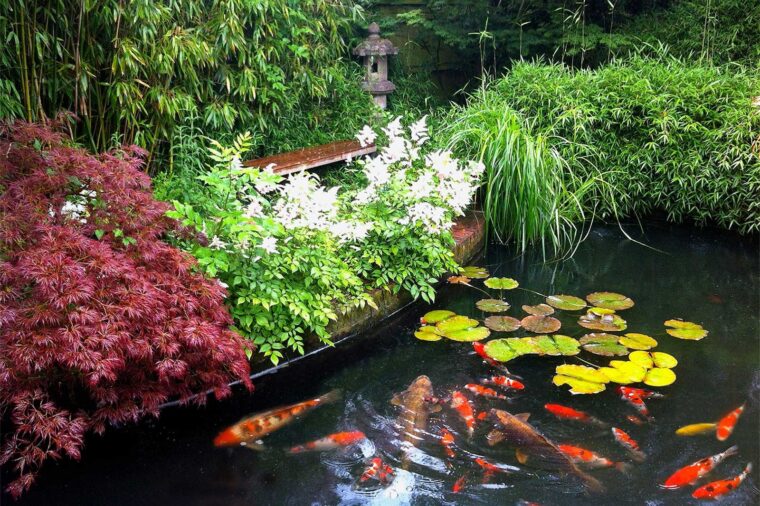
Creating a pond environment that supports migratory birds depends on thoughtful planning and plant selection.
Three core principles form the foundation for a healthy, functional habitat:
- Using native plants
- Diversifying plant types
- Designing for safe access and shelter
- Lake and pond equipment
Every principle works together to provide food, cover, and water quality improvements while keeping the ecosystem balanced.
Choose Native Plants
Native plants are naturally adapted to local rainfall patterns, seasonal temperature changes, and soil types, which means they thrive without constant care. These species also maintain the natural food web.
Native insects, such as caterpillars, beetles, and aquatic larvae, are more abundant on plants they evolved alongside.
Birds benefit directly because these insects form a reliable food source during migration.
Using plants grown from local seed sources ensures genetic traits match the region’s conditions, reducing the risk of transplant shock and increasing long-term survival rates.
Key Points:
- Adapted to local climate and soil, reducing maintenance needs.
- Support native insect populations that birds depend on for food.
- Lower transplant shock when sourced from local growers.
- Contribute to a stable, self-sustaining habitat.
Diversify Plant Types
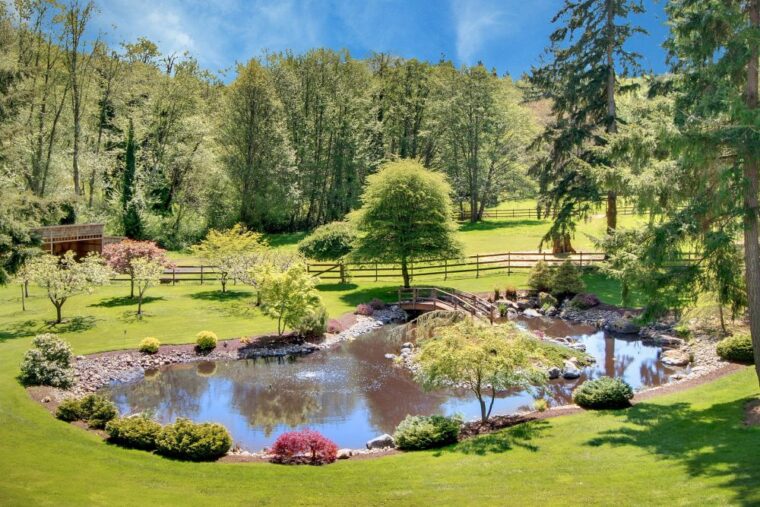
A balanced pond environment relies on a variety of plant forms.
Submerged species oxygenate the water and provide habitat for aquatic life.
Floating plants create shaded zones for insects and small fish.
Marginal plants stabilize shorelines and offer nesting cover. Including flowering plants, fruiting shrubs, and seed-producing species ensures food is available at different times of the year.
Key Points:
- Use submerged, floating, and marginal plants to build habitat layers.
- Include flowering, fruiting, and seed-producing plants for year-round resources.
- Support pollinators, aquatic insects, and seed-eating birds.
- Improve water clarity and reduce erosion with structural variety.
Create Access and Shelter
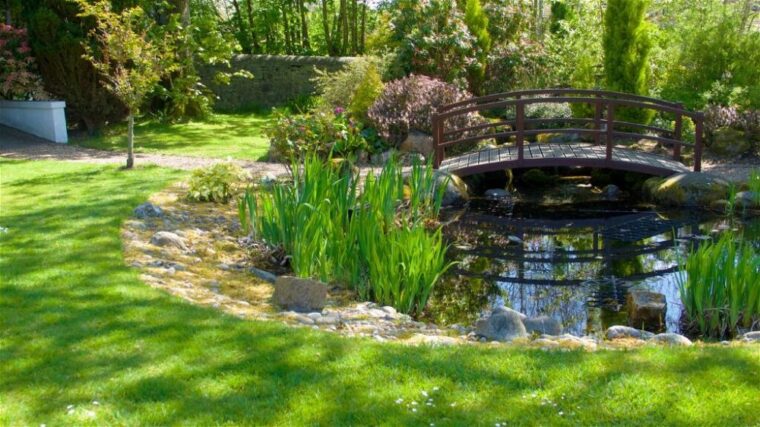
Safe access to water is essential for birds to drink, bathe, and forage.
Gentle shorelines, flat stones, or gravel shelves make it easier for birds to approach without risk.
Dense shrubs and small trees around the pond act as quick escape routes from predators, while driftwood, brush piles, and upright stems create perches for resting, sunning, or hunting.
Windbreaks made of vegetation reduce cold winds, allowing migratory birds to conserve energy during stopovers.
Key Points:
- Provide gradual slopes or stable surfaces for safe water entry.
- Plant shrubs and small trees for cover and predator protection.
- Add natural features like logs or brush piles for perching and resting.
- Use vegetation as windbreaks to reduce stress on birds.
Lake and Pond Equipment
Maintaining a pond that supports migratory birds involves more than planting the right vegetation. Proper equipment keeps the water clean, oxygenated, and stable, ensuring plants and wildlife thrive year-round.
The right tools can also help manage algae, control water levels, and protect sensitive shoreline zones.
Integrating equipment into pond care not only benefits plants but also boosts food availability and shelter quality for visiting birds.
Aeration Systems
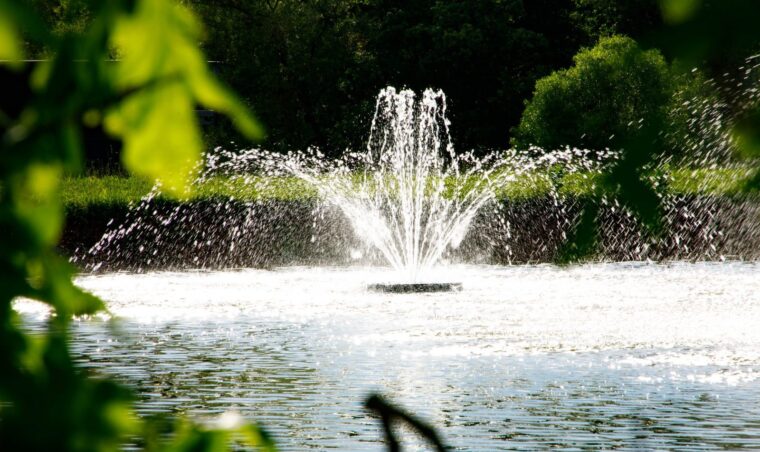
Aerators circulate water, increasing oxygen levels that support fish, aquatic insects, and beneficial bacteria.
Healthy oxygen levels prevent stagnant conditions that could harm plants and reduce insect activity, both of which affect bird foraging.
Filtration Units
Filters remove excess nutrients and suspended particles, helping maintain water clarity.
Cleaner water supports submerged plants that serve as foraging grounds for insect-eating birds.
Water Pumps
Pumps keep water moving, reducing mosquito breeding sites and maintaining a healthy habitat. They also help distribute oxygen evenly throughout the pond.
Key Points:
- Maintain oxygen levels with aerators for healthier plant and animal life.
- Use filters to keep water clear for submerged vegetation.
- Prevent erosion and protect shoreline plants with stabilization materials.
- Keep water in motion to discourage pests and support balanced habitats.
- Manage seasonal changes with debris removal and ice prevention tools.
Plant Categories and Recommendations

Designing a pond that serves migratory birds effectively involves selecting plants that meet specific needs for food, shelter, and water quality.
Grouping plants by their functional role helps ensure every part of the pond ecosystem supports bird life.
Marginal and Shoreline Plants (Shelter and Nesting Cover)
Marginal and shoreline plants grow along the pond’s edge, where shallow water meets land.
These plants stabilize banks, reduce erosion, and provide shelter for birds and amphibians.
Many also offer nectar, seeds, or insect habitat that directly benefits wildlife.
Buttonbush (Cephalanthus occidentalis) produces spherical flower heads rich in nectar for pollinators, followed by seeds that feed ducks and other waterfowl. Dense growth offers nesting cover.
Yellow Flag Iris (Iris pseudacorus) is a tall plant that provides shade and nesting areas, while its roots filter excess nutrients. Replace with a native iris in regions where it may become invasive.
Marsh Marigold (Caltha palustris) is an early spring blooms that attract pollinators and indicate areas with high insect activity.
Brooklime (Veronica beccabunga) forms low mats that protect banks and create safe pathways for amphibians.
Water Mint (Mentha aquatica) as aromatic leaves deter some pests, and summer blooms draw large numbers of pollinators.
Key Points:
- Stabilize pond banks and prevent erosion.
- Offer nesting, roosting, and shelter opportunities.
- Provide nectar, seeds, and insect-rich foraging areas.
- Attract amphibians and aquatic insects important in bird diets.
Floating Plants (Shade and Insect Habitat)
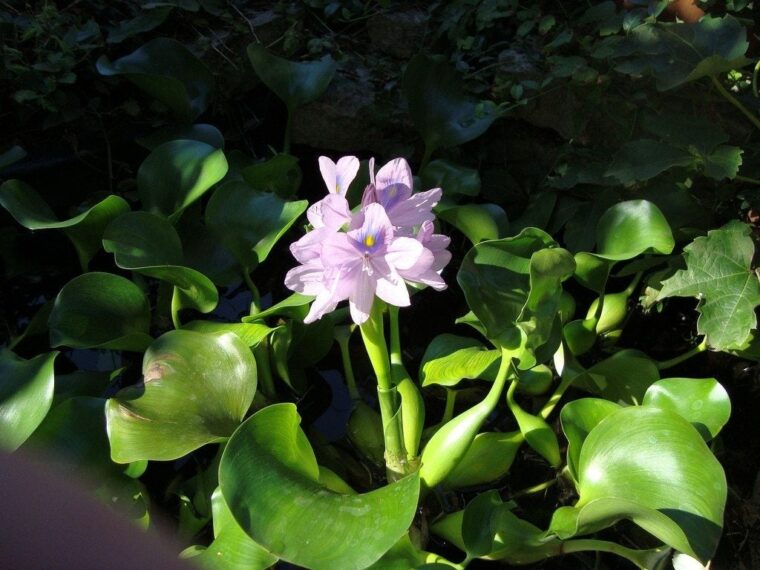
Floating plants create shaded microhabitats, reducing water temperature and encouraging insect activity. They also provide hiding places for aquatic larvae and small fish, which in turn attract birds.
Frogbit (Hydrocharis morsus-ranae) forms floating rosettes that give shade and shelter to aquatic creatures, while flowers offer nectar.
Greater Duckweed (Spirodela polyrhiza) creates dense mats that serve as cover for larvae and other small aquatic organisms.
Water Soldier (Stratiotes aloides) offers seasonal habitat by floating in summer and sinking in winter, protecting aquatic life year-round.
Key Points:
- Offer shade that reduces overheating of shallow waters.
- Shelter aquatic insects and larvae.
- Support food chains that benefit insectivorous birds.
- Slow surface water movement, reducing erosion.
Submerged Plants (Oxygenators and Aquatic Foraging Zones)
Submerged plants play a vital role in oxygenating water and providing habitat for aquatic insects and small fish. Birds often forage in areas rich with submerged vegetation because prey density is higher.
- Hornwort (Ceratophyllum demersum): Free-floating oxygenator that provides shelter for invertebrates and juvenile fish.
- Water Violet (Hottonia palustris): Offers fine submerged leaves for insect habitat and blooms that feed early-season pollinators.
- Water Crowfoot (Ranunculus aquatilis): Supports aquatic insect life with submerged foliage and floating flowers.
Key Points:
- Increase oxygen levels in pond water.
- Provide nursery areas for aquatic invertebrates.
- Attract insectivorous birds to feed in shallows.
- Help maintain water clarity and health.
Flowering and Fruit-Bearing Plants Near Pond Edges
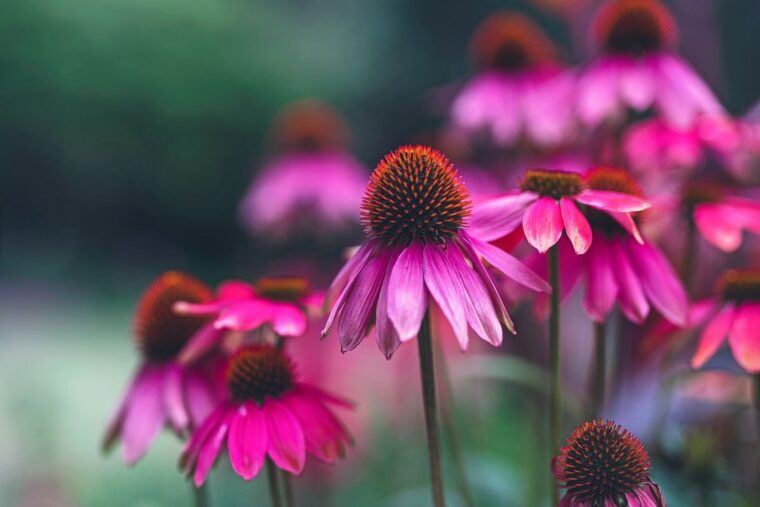
Plants in this category supply nectar, seeds, and fruit that help birds fuel up before or during migration. Many also provide shelter or materials for nest building.
Purple Coneflower (Echinacea spp.) produces nectar for pollinators in summer and seeds for finches in autumn.
Sunflowers (Helianthus spp.) yield large seed heads that feed birds in the late season.
Milkweed (Asclepias spp.) hosts monarch larvae and offers nesting fiber from seed floss.
Cardinal Flower (Lobelia cardinalis) attracts hummingbirds during migration with vibrant red blooms.
Elderberry (Sambucus spp.) produces fruit in late summer for thrushes and other species.
Dogwoods (Cornus spp.) offer autumn fruit and dense branches for cover.
Key Points:
- Supply food in the form of seeds, nectar, and fruit.
- Attract pollinators that, in turn, support insect-eating birds.
- Provide materials for nest construction.
- Support birds throughout different migration stages.
Summary
Planting a layered palette of native, pond-friendly species turns water and shore into a dependable refueling stop.
Migrants gain food, cover, and clean water, while local insects, amphibians, and fish benefit at the same time.
Careful choices today set up seasonal abundance for years to come, creating a small sanctuary that truly supports bird conservation.
